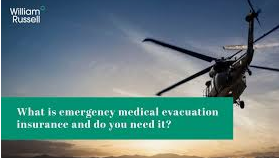Getting Started
A vital part of any travel or health insurance policy is evacuation coverage, which is frequently disregarded. Whether traveling locally or abroad, it guarantees that people can get the medical treatment they need or flee dangerous situations. This all-inclusive guide will examine evacuation insurance in detail, delving into its significance, coverage details, cost factors, and practical uses. Readers will leave this essay with a solid grasp of the importance of evacuation insurance and the tools they need to make educated decisions in this area.
Exploring the Concept of Evacuation Insurance
Can You Explain Evacuation Insurance?
When a policyholder needs to be transported to a different place for medical treatment, evacuation insurance—also called medical evacuation insurance or emergency evacuation insurance—covers the transportation expenses. Air ambulance services, medical repatriation, and non-medical evacuation are all examples of what can be considered emergencies in times of political upheaval, natural disasters, or other situations.
Different Forms of Emergency Coverage
1. Medical Evacuation Insurance: This policy will pay to get you to a good hospital if you get really sick or hurt while you’re on the road.
2. Non-Medical Evacuation Insurance: This pays for people to leave their homes in the event of non-medical crises like earthquakes, riots, or other unanticipated dangers.
3. Repatriation Insurance: This type of insurance pays to get the policyholder back to their home country once they’ve had the medical treatment they need.
What is the Significance of Evacuation Insurance?
For multiple reasons, evacuation insurance is crucial:
1. Access to Sufficient Medical Treatment: Many rural or impoverished areas may lack sufficient medical services. Travelers can rest assured that they will be able to get the medical attention they need if they purchase evacuation insurance.
2. Managing Expenses: Medical evacuations can be extremely expensive, sometimes reaching tens of thousands of dollars. Having evacuation insurance can assist alleviate financial strain during emergencies by reducing these expenditures.
3. Peace of Mind: Travelers may relax and enjoy their trip more when they have evacuation insurance to cover any unexpected medical costs.
4. Non-medical evacuation insurance guarantees that passengers can be safely evacuated from countries prone to political turmoil or natural disasters, providing them with a sense of security in these regions.
Detailing the Coverage
Evacuation Insurance: What Is It Good For?
The following are usually covered by evacuation insurance:
1. Medical Transportation: Medical transportation to the closest suitable medical facility, whether by air ambulance, ground ambulance, or any other means.
2. Medical Repatriation: After the policyholder’s condition stabilizes, transportation back to their native country is covered.
3. Non-Medical Evacuation: Leaving the area due to political instability, natural disasters, or other serious situations.
4. Escort Services: This coverage allows the policyholder to bring a family member or medical professional with them throughout the evacuation.
5. Travel Arrangements: Planning and execution of the evacuation, including communication with airlines and making arrangements for ground transportation.
What Is Not Included?
While specifics may differ from policy to policy, evacuation insurance usually does not pay for:
1. Routine Medical Care: This includes things like immunizations, checkups, and treatments that aren’t considered emergencies.
2. Pre-existing Conditions: Evaluations pertaining to medical issues that were present prior to the policy’s purchase.
3. Situations Not Classified as Emergencies: Whenever an evacuation is neither medically required nor connected to a major danger.
4. Personal Expenses: Unless otherwise specified in the insurance, this includes things like food, hotel, and transportation costs incurred by the insured individual while evacuating.
Policy Restrictions and Absences
Limitations and exclusions commonly found in evacuation insurance contracts include:
1. Coverage Limits: The maximum amount that the insurance will pay for evacuation services.
2. Geographic Exclusions: Coverage may not extend to all countries or areas.
3. Duration Limits: Dictate how long a trip’s coverage is valid.
4. Medical Necessity: A physician’s certification stating that the evacuation is medically necessary is required.
Factors Relating to Cost
Cost-Relating Elements
Several factors determine the cost of evacuation insurance:
1. Destination: Premiums tend to be higher for trips to outlying or dangerous locations.
2. Health and Age: Premiums could be more expensive for passengers who are older or have health issues.
3. Trip Length: Evacuation insurance premiums tend to be higher for trips that are longer.
4. Amount of Coverage: More extensive insurance and higher coverage limits will have a higher price tag.
5. Travel Type: Insurance rates might go up for vacations that include adventure travel or other high-risk activities.
Standard Expenses
Here are some ballpark figures, though prices can range greatly:
1. Travel for a Limited Time: The cost of evacuation insurance for a one-week trip can range from $50 to $150.
2. Long-Term Travel: $500 to $2,000 can be spent on a six-month journey.
3. Annual Policies: Those who travel a lot might want to consider an annual policy, which can range in price from $300 to $1,500.
Methods to Reduce the Cost of Evacuation Coverage
1. Combine Policies: Evacuation insurance, when combined with other travel insurance policies, can occasionally lead to reductions.
2. Group Plans: Organizations and families can often save money by purchasing group travel coverage.
3. Credit Card Benefits: Travel insurance is a perk of some credit cards.
4. Membership Programs: The availability of evacuation services through membership programs offered by groups such as Medjet and Global Rescue.
Deciding on the Appropriate Policy
Evaluate Your Requirements
1. Destination Risks: Think about the healthcare options and political stability where you’re going.
2. Personal Health: Assess your health and whether you may require medical evacuation based on your conditions.
3. Travel Frequency: Think about how often you travel and whether a yearly or single-trip policy would be more economical.
4. Activities Scheduled: Consider specialized coverage for high-risk activities.
Weighing Service Providers
1. Coverage Options: Compare the types of evacuations covered and coverage limits.
2. Cost: Consider the premiums and any possible out-of-pocket expenses.
3. Provider Reputation: Look into the provider’s reputation by reading reviews and testimonials from previous clients.
4. Responsiveness: Get to know the provider’s responsiveness and the claims process.
Reputable Companies for Emergency Coverage
1. Allianz Global Assistance: Recognized for extensive security and a robust international framework.
2. Medjet: Focuses on rep
atriation and medical evacuation.
3. Global Rescue: Provides services for both medical and non-medical evacuations.
4. Travel Guard: Offers a range of travel insurance plans, one of which includes evacuation coverage.
Practical Utilization
Examples of Real-World Application
1. Rescue at an Unexpected Location: A hiker in the Himalayas sustains a serious injury while on the road. The expense of an air ambulance ride to a Kathmandu hospital and return to their home nation can be covered by evacuation insurance.
2. Natural Disaster Evacuation: Occurs when a hurricane hits while a tourist is on vacation in the Caribbean. The cost and arrangement of transportation to a secure place can be covered by non-medical evacuation insurance.
3. Political Unrest: A business traveler visiting a nation with a fragile political climate may experience unexpected upheaval. Returning home safely is coordinated by the insurance company.
Review Criticism
1. John’s Story: “I became really sick while on an African safari. My evacuation insurance paid for my medical treatment at a South African hospital. Everything was paid for by my insurance, and the attention I received was second to none.”
2. Sarah’s Story: “A political coup occurred when I was in Southeast Asia. I was taken to a nearby nation in a safe manner until it was safe to go back home, thanks to my evacuation insurance.”
In Summary
Travelers should always have evacuation insurance in case of any kind of emergency, whether it’s a medical emergency or not. Travelers can make sure they’re covered by learning about the many kinds of coverage, what factors affect the costs, and how to purchase the correct policy. Having evacuation insurance can provide financial security and peace of mind for adventurers venturing into uncharted territories as well as business travelers visiting places with unstable governments. Before settling on a plan, it’s a good idea to figure out what you need, look into your options, and read the fine print. Best regards!

